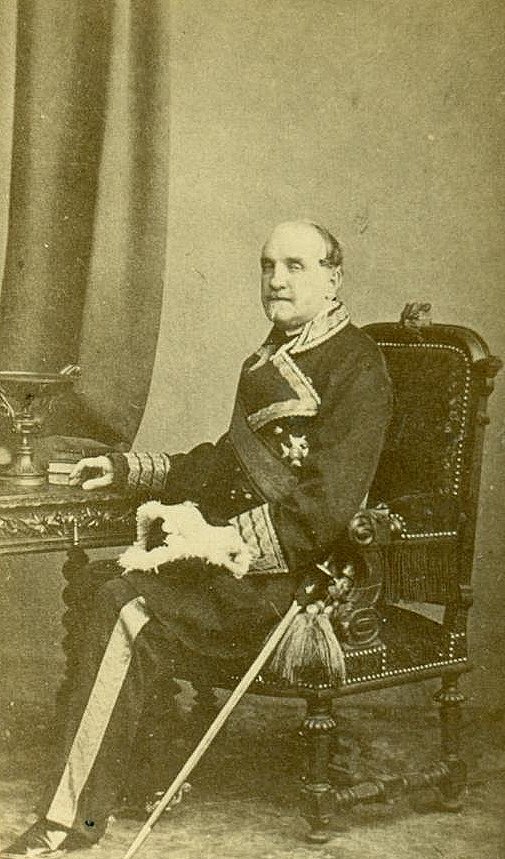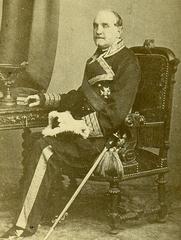
Leopoldo O’Donnell Monument Madrid: Visiting Hours, Tickets, and Comprehensive Guide
Date: 14/06/2025
Introduction: The Significance of the Leopoldo O’Donnell Monument
Madrid, Spain’s vibrant capital, is renowned for its rich tapestry of historical landmarks. Among these, the Leopoldo O’Donnell Monument and related sites serve as enduring tributes to Leopoldo O’Donnell y Jorís, 1st Duke of Tetuan. A distinguished 19th-century general and statesman of Irish-Spanish descent, O’Donnell played a pivotal role in Spain’s military and political transformations, particularly during the Carlist Wars and the Spanish-Moroccan War. His legacy, marked by military triumphs and statecraft, is reflected in Madrid’s monuments, mausoleums, and public spaces.
This guide explores the historical and artistic significance of the Leopoldo O’Donnell Monument, the Mausoleum within the Parroquia de Santa Bárbara, and the urban landscapes of Plaza de O’Donnell and Calle de O’Donnell. You’ll find detailed visitor information—hours, ticketing, accessibility, travel tips—and insights into nearby attractions. Whether you are passionate about military history, art, or urban culture, these sites offer multifaceted perspectives on Leopoldo O’Donnell’s enduring influence and Madrid’s storied past.
Contents
- Discover the Leopoldo O’Donnell Monument in Madrid
- Historical Background
- Monument Overview and Cultural Importance
- Visiting Information
- Travel Tips and Nearby Attractions
- Guided Tours and Photography
- The Mausoleum of Leopoldo O’Donnell
- Architecture and Artistic Features
- Symbolism and Historical Context
- Visiting Hours, Tickets, and Accessibility
- Guided Tours and Photography
- Travel Tips and Conservation
- Exploring O’Donnell-Related Sites in Madrid
- Historical Context and Legacy
- Visiting Practicalities
- Plaza de O’Donnell and Calle de O’Donnell
- Artistic Connections and Events
- Visitor Experience and Travel Advice
- Summary and Final Tips
- Sources and Further Reading
Discover the Leopoldo O’Donnell Monument in Madrid
Historical Background
Leopoldo O’Donnell y Jorís (1809–1867) emerged as a major figure in 19th-century Spain. Born in the Canary Islands, he ascended through the military ranks during the Carlist Wars and later held the position of Prime Minister multiple times. His leadership during the Spanish-Moroccan War earned him the title Duke of Tetuan, and his reforms and military endeavors marked turning points in Spanish history (International Diplomat).
Monument Overview and Cultural Importance
The Leopoldo O’Donnell Monument stands in Plaza del Marqués de Salamanca. Erected in the late 1800s, the monument features a bronze statue of O’Donnell atop a stone pedestal, with intricate reliefs illustrating key episodes from his career. The monument encapsulates Spain’s turbulent 19th century and pays homage to a figure who shaped the nation’s military and political landscape (Madrid Tourism).
Visiting Information
- Location: Plaza del Marqués de Salamanca, Madrid
- Opening Hours: Open-air, accessible 24/7
- Admission: Free
- Accessibility: Wheelchair accessible with nearby paved paths
Travel Tips and Nearby Attractions
The Salamanca district, home to the monument, is celebrated for its elegant architecture, upscale shopping, and vibrant cafes. Notable nearby attractions include Retiro Park, the Prado Museum, and Paseo de la Castellana.
Guided Tours and Photography
Numerous Madrid walking tours include the monument, offering historical narratives and local insights. The monument is particularly photogenic at sunrise or sunset, with Madrid’s cityscape providing a striking backdrop.
The Mausoleum of Leopoldo O’Donnell
Architecture and Artistic Features
Located inside the Parroquia de Santa Bárbara, the Mausoleum of Leopoldo O’Donnell is a striking example of 19th-century neoplateresque architecture, echoing the ornate Renaissance Plateresque style. The mausoleum, measuring roughly 4 by 7 meters, features classical arches, pilasters, and a triangular pediment topped with a Latin cross, embodying solemnity and grandeur (Sitios Históricos).
Symbolism and Historical Context
Renowned sculptor Jerónimo Suñol created the lifelike effigy of O’Donnell, depicted in his Captain General uniform and draped with the Order of San Fernando and Grand Cross Laureate. The mausoleum’s angels and O’Donnell coat of arms symbolize divine protection and martial valor, reflecting the blend of religious faith and noble military tradition. The design commemorates O’Donnell’s victory at Tetuan and situates his memory within Spain’s imperial and artistic heritage (military-history.fandom.com).
Visiting Hours, Tickets, and Accessibility
- Location: Parroquia de Santa Bárbara, Calle General Castaños 2, corner with Calle Bárbara de Braganza, 28004 Madrid
- Hours:
- Weekdays: 09:00–13:00, 18:00–21:00
- Saturdays/holiday eves: 10:00–13:00, 18:00–21:00
- Sundays/holidays: 10:00–14:00, 18:00–21:00
- Admission: Free
- Metro: Alonso Martínez or Colón stations
- Accessibility: Pedestrian-friendly; check with the church for specific accommodations
Guided Tours and Photography
While there are no regular guided tours dedicated to the mausoleum, it is often included in broader historical tours. Photography is generally permitted, but visitors should be discreet and avoid flash. Special events and cultural activities occasionally offer unique opportunities to experience the mausoleum in a different context.
Travel Tips and Conservation
Visit during daylight for optimal lighting, and enter via the main aisle for the best view of the mausoleum. The church’s preserved environment ensures the monument’s conservation and offers a peaceful setting for reflection.
Exploring O’Donnell-Related Sites in Madrid
Historical Context and Legacy
Leopoldo O’Donnell’s enduring impact can be traced throughout Madrid. His leadership as Prime Minister and military commander is commemorated not only in monuments but also in public spaces and art (Museo de la Historia de Madrid).
Visiting Practicalities
- Transportation: Easily accessible via Metro and city buses. The Madrid City Card offers unlimited public transport and discounts (esMadrid).
- Best Seasons: Spring and autumn, for mild weather and fewer crowds.
Plaza de O’Donnell and Calle de O’Donnell
Plaza de O’Donnell
This lively square, though lacking a dedicated monument, serves as a vibrant entrance to the Retiro district. It is a hub of urban life, surrounded by notable architecture, shops, and cafes. Open 24/7 with no admission fee.
Calle de O’Donnell
Stretching east-west, Calle de O’Donnell links the city center with eastern districts. The avenue boasts a blend of residences, embassies, and commercial spaces, and is ideal for walking tours and urban exploration. Metro Line 6 (O’Donnell station) provides direct access.
- Accessibility: Wide sidewalks, curb cuts, ramps, and accessible public transit.
- Amenities: Public restrooms in Retiro Park, free Wi-Fi in many cafes, diverse dining and shopping options.
Artistic Connections and Events
O’Donnell’s legacy is present in Spanish art history. The celebrated portrait by Raimundo de Madrazo y Garreta, formerly at the Prado, underscores his cultural significance (Tourtime.es). While the original is currently off display, reproductions can be found in digital archives.
Madrid occasionally features O’Donnell in exhibitions and public lectures focused on 19th-century history and national identity (UNWTO).
Visitor Experience and Travel Advice
- Guided Tours: Several historical walking tours include O’Donnell-related sights.
- Self-Guided Walks: Begin at Plaza de O’Donnell, stroll Calle de O’Donnell, and explore nearby Retiro Park and the Royal Academy of Fine Arts.
- Photography: Capture the urban and architectural ambiance; always respect privacy and museum photography policies.
- Safety: The O’Donnell area is safe; standard city safety measures apply.
- Language: Spanish is the main language; English is widely spoken in tourist zones.
Summary and Final Tips
The Leopoldo O’Donnell sites in Madrid—spanning monuments, mausoleums, and city streets—offer a window into Spain’s 19th-century military, political, and artistic evolution. These landmarks, accessible year-round and free to visit, provide a meaningful experience for history lovers and urban explorers alike. Enhance your trip by joining a guided tour, attending cultural events, or exploring adjacent museums and parks. For the most rewarding visit, plan for spring or autumn, consult official tourism resources, and consider using the Audiala app for interactive guides.
Embark on an exploration of Leopoldo O’Donnell’s legacy to gain a deeper understanding of Madrid’s historical identity and the figures who shaped modern Spain (Sitios Históricos, Madrid Official Tourism, Tourtime.es).
Sources and Further Reading
- Leopoldo O’Donnell Monument in Madrid: Visiting Hours, History, and Tourist Guide (Madrid Tourism)
- Discovering the Mausoleum of Leopoldo O’Donnell: Artistry, Symbolism & Visiting Information at Madrid Historical Site (Sitios Históricos)
- Cultural and Historical Significance of Leopoldo O’Donnell, 1st Duke of Tetuan (International Diplomat)
- Visiting Plaza de O’Donnell and Calle de O’Donnell: Hours, Tickets, and Madrid Historical Sites (Tourtime.es)
- Museo de la Historia de Madrid (Museo de la Historia de Madrid)
- Official Madrid Tourism Site (Madrid Official Tourism)
- UNWTO Cultural Tourism Resources (UNWTO)


































































































